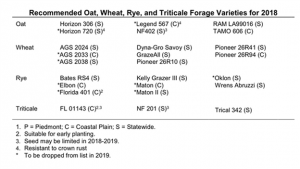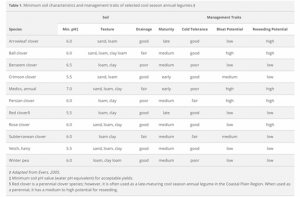By Jeremy Kichler
Colquitt County CEC
Winter annual crops can make excellent food plots for wildlife. Cool season grasses include wheat, oats, rye, and triticale. Clovers can be planted in food plots in order to attract insects and produce seed for birds.
Soil Sample
One of the first things wildlife enthusiasts need to do is take a soil sample. A soil sample can tell us information such as pH and soil nutrients which is important in order to produce great looking food plots. When taking soil samples please take a representative sample of the plot. Take into consideration factors such as changes in soil type. Soil samples can be done by digging or using a soil probe (dig or probe down about 4 to 6 inches) from 10 to 20 locations in the food plot. Keep in mind, if soil pH is low then we can adjust this with a lime application. Lime reacts slowly and needs to be applied two to the three months before food plot establishment. If you have questions about soil sampling please contact your local county Extension agent.
Fertilization
If you are trying to grow cool season annual grasses such as rye, wheat and oats in the food plot then consider 50 units of N applied at planting and another 50 units of N in late winter. If you are utilizing clovers and cool season grasses in the forage mix then consider 25 units of N at planting and another 25 units in late winter. If it is required to apply P and K on the food plot please do so at planting. If you are planting just clovers or other legumes for food plots then no nitrogen is needed. Remember to inoculate your clovers at planting to ensure proper nitrogen fixation during the season.
Variety Selection
Select winter annual forage varieties that are on the recommended list can be found on the UGA Forages website (www.georgiaforages.com). Recommended varieties have consistently demonstrated above average yields in UGA variety trials. Other varieties may provide satisfactory yields, but might not have been consistent.
Below are recommended small grain forage varieties:

Clovers are real popular for food plots. According to UGA Forages, AU-Robin is a recommended crimson clover variety. Dixie would be an acceptable for plantings if AU-Robin is not available. Below is a table discussing the soil characteristics and management traits of selected cool season annual legumes.

Seeding Rates
A great resource I would suggest is the publication Planting Guide to Grasses and Legumes for Forage and Wildlife in Georgia
Seeding Depth
Planting depth can be challenge for food plot establishment. Small seeded clovers should not be planted deeper than ¼ to ½ inch deep. Plant small grain seed one to 1.5 inches deep for successful stand establishment. Ideally, small-seeded legumes should be planted using a cultipacker-seeder (prepared seedbeds only) or the small-seed box on a no-till or conventional drill. This provides the most accurate seeding rate control. However, the use of a no-till or conventional drill often results in small-seeded legumes being planted too deep (i.e., deeper than ½-inch). Some drills cannot be adequately adjusted to maintain a consistently shallow planting depth. Planting depth is harder to control when planting into wet soil, a soft seedbed or rough ground.
If these equipment or condition limitations exist, successful seed placement can occur if the seed are broadcast directly behind the drill’s shoes and in front of the press wheels. To do this, disconnect the tubes from the small seed box where it enters the drill’s shoes and secure the tubes behind the shoes or in front of the press wheels with wire or cable ties. This should allow the seed to be metered out on the soil surface, and the press wheels (with proper down-pressure) should firm the soil around the seed. This practice will ensure that the seeds are not planted too deep.
Accurately broadcasting small-seeded legumes (i.e., legumes with seeding rates less than eight to 10 lbs/acre) is difficult with large spinner-spreaders. If the available equipment cannot be adjusted to apply the low rate that is required, the inoculated seed can be mixed with coarse sand or some other inert material that is similar in size and weight. Smaller seeds should not be mixed with larger seeds in the hopper or seed boxes, since the small seeds will settle to the bottom. Also, legume seeds should not be mixed with fertilizer, since the fertilizer may kill the inoculant.
Broadcasted seed may not have sufficient seed-soil contact. Conventional-till seedbeds should be firmed with a cultipacker before seed are broadcast. Footprints left by an average person on a properly prepared seedbed should not be more than ¼-inch deep. Broadcast seeding on a prepared seedbed should be followed with adequate firming of the seedbed with a cultipacker.
If you have any questions about food plots, forages or soil sampling please contact your local county Extension agent.